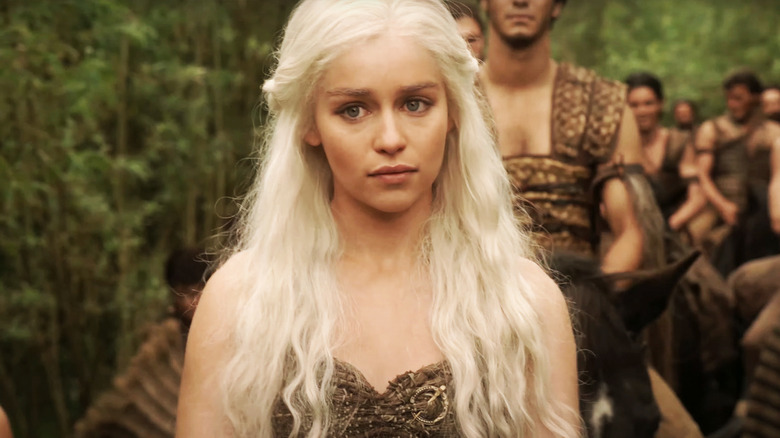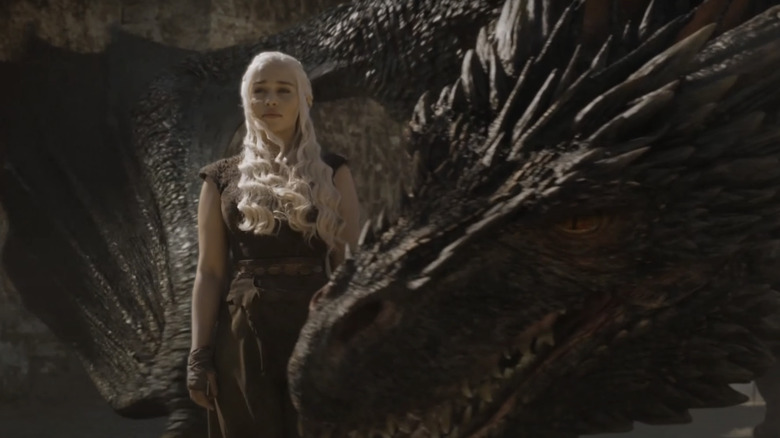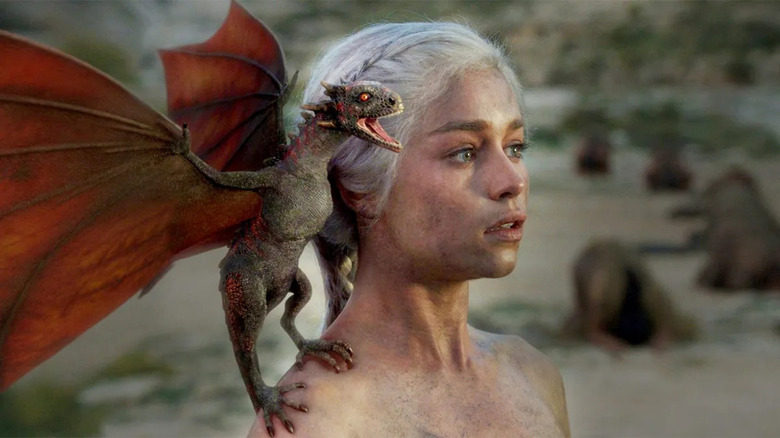Emilia Clarke's Legs Created A 'Nightmare' For Game Of Thrones' VFX Team
There's a lot of bad CGI out there these days, from CGI monsters that missed the mark to the truly abysmal digital effects in last year's "The Exorcist: Believer." But as any avid viewer of the Corridor Crew's "VFX Artists React" series will know, there's also a lot of awe-inspiring stuff being done with CGI. James Cameron's "Avatar: The Way of Water" included a scene so convincing it had us questioning reality, and there's been no shortage of jaw-dropping CGI moments in "Star Wars" history.
Often, due to the prevalence of CGI in modern filmmaking, we don't necessarily think about the incredibly meticulous work that goes into creating such moments. Take "Game of Thrones" for instance. In a show as epic and effects-laden as HBO's monster hit series, you might expect the VFX artists to have encountered issues with rendering the variety of exotic beasts or grand landscapes. In reality, the big problem was legs. Specifically, Emilia Clarke's legs.
Through no fault of her own, the Daenerys actress apparently caused no end of headaches for the "Game of Thrones" VFX team, who found their ingenious solution for depicting the Princess of House Targaryen atop a dragon wasn't quite as foolproof as they thought.
Riding a CGI dragon is trickier than you might think
After beginning "Game of Thrones" as an exiled princess, Daenerys evolves throughout the series to become a queen, conquering Slaver's Bay along the way and renaming it to the Bay of Dragons. Of course, part of that journey involves the Mother of Dragons actually starting to fly atop her winged companions, with the "GoT" crew promising "dragons the size of 747s" for the series' seventh season. As Pixomodo VFX supervisor Derek Spears recalled in an interview with Vulture, "Game of Thrones" seasons 6 and 7 marked the start of Daenerys' dragon-flying exploits, which threw up some unexpected VFX challenges.
While it might sound like a fairly simple task in the age of CGI to render Emilia Clarke riding a flying dragon, it actually proved to be trickier than you might think. As Spears explained:
"One of the things we learned, doing season five, was that when those dragons flew out of the arena, it looked a little bit too simple, because the cameras didn't move. We thought, well, next season we should move the cameras more, and move her more, too."
To create this effect, Spears and the team used a wooden "buck" as a stand-in for the dragon, which Clarke would sit atop while the crew figured out all their camera moves and motion control. Unfortunately, there was an almost fatal flaw in this plan ...
The wooden dragon came with unforeseen issues
Using a big hunk of wood as a fake dragon might seem like a decent enough solution to depicting Emilia Clarke atop one of her flying beasts. But as Derek Spears explained, a fairly big issue soon cropped up:
"What we found out is that dragons aren't like solid pieces of wood. They move, and when they move, they flex, and their muscles move too. So we had the dragon flying and the muscles moving — but Dany's legs didn't react to any of it. So we had to replace her legs."
In the history of CGI, there have surely been more complex tasks than swapping out an actor's legs with digital counterparts. But the trouble came with the sheer amount of shots that required Daenerys' limbs to be digitally manipulated. Spears continued:
"We ended up replacing her legs on so many of the shots just to get it to follow the trap muscles on the back of the dragon. It was a nightmare. Everything else in those sequences was easy compared to trying to get her to sit on top of the stupid dragon with its stupid muscles. Some of the shots, we replaced her legs completely; others we mapped them on to a new piece of geometry and moved them around. Literally we had to deform the lower half of her body to make it fit."
The biggest issue appears to have been Clarke's knees, which would slide across the surface of the dragon, immediately detracting from the effect. According to Spears, that "one little detail was probably half the labor that went into those shots." Thankfully the crew rallied and things worked out. It's a shame the same can't be said of the final season of "Game of Thrones," though.


